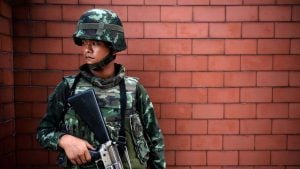Andaman & Nicobar Command gets new Chief
- Lieutenant General Manoj Pande assumed command of Andaman & Nicobar Command.
- It is a Tri-Service Command of the Indian Armed Forces, based at Port Blair in the Andaman and Nicobar Islands.
- It was created in 2001 to safeguard India’s strategic interests in Southeast Asia and the Strait of Malacca by increasing rapid deployment of military assets in the region. It provides logistical and administrative support to naval ships which are sent on deployment to East Asia and the Pacific Ocean.
- The Andaman and Nicobar Command is commanded by a Three-star officer (rank of Lieutenant General of the Indian Army or equivalent) who reports directly to the Chairman of the Chiefs of Staff Committee (Chairman COSC) in New Delhi.
- The Chief of Staff of the command is a two-star officer; each component (sea, land, air) is commanded by a one-star officer.
Lieutenant General RP Singh PVSM AVSM VSM visits Vajra Corps
- Army Commander of Western Command visited the formations of Vajra Corps (XI Corps) to review the operational & COVID19 preparedness.
- He also inaugurated newly constructed Astro Turf Hockey Ground for the Army Services Hockey Node at Jalandhar Cantonment.
- The XI Corps of the Indian Army is based in Jalandhar and is a part of Western Command.
World Environment Day 2020 Indian Navy’s Green Footprint to its Blue Water Operations
- Environment Protection and Green Initiatives have always been a key focus area of the Indian Navy. A responsible multi-dimensional force, the Indian Navy has embarked on reducing its environmental footprint through energy conservation, minimising marine pollution and use of alternative sources of energy. The ‘Indian Navy Environment Conservation Roadmap’ (INECR) has been the guiding document and key enabler for progressively achieving this vision of the Indian Navy to add a Green Footprint to its Blue Water operations.
- Indian Navy conducted the World Environment Day this year adhering to the lockdown measures in force. Educational awareness programs, lectures and webinars were conducted over electronic media in Naval stations in lieu of the otherwise regular outdoor activities.
- With the aim of reducing pollution from engine exhausts, the Indian Navy collaborated with IOCL to revise the fuel specifications. The new specification surpasses international norms and includes reduced sulphur content which in the long run will reduce emissions levels as well as maintenance requirements onboard. Whilst recognising the significance of biodiversity, which incidentally is the theme for World Environment Day-2020, ample emphasis is being accorded within the Navy in protecting ocean ecology.
- Indian Navy has voluntarily implemented all six schedules of International Convention for the Prevention of Pollution from Ships (MARPOL) regulations. All Naval ships have been fitted with MARPOL compliant pollution control equipment such as Oily Water Separators (OWS) and Sewage Treatment Plants (STP) for treating waste generated onboard. Further, to ensure upkeep of harbour waters, accelerated bioremediation technology has also been developed through Naval Materials Research Laboratory (NMRL), Mumbai.
- In efforts to reduce carbon footprint, measures have been brought in force for a steady increase in utilisation of e-vehicles such as e-cycles, e-trolley and e-scooters. As a long-term strategy, it is being planned to gradually reduce the usage of fossil-fuel based vehicles during working hours through use of e-vehicles or bicycles. To promote the same, units observe ‘No Vehicle Days’ regularly and the concept of a ‘Vehicle Free Base’ is also being introduced in some Naval establishments.
- An ongoing area of focus within the Navy, is the reduction of overall power consumption through a progressive induction of energy efficient equipment. Substantial efforts have yielded a near-complete transition from conventional lighting to more energy efficient solid-state lighting. Other notable energy saving measures incorporated across Indian Navy establishments include use of capacitor banks to maintain high power factor, use of transparent acrylic sheet roofs to harness natural light, SCADA (Supervisory Control and Data Acquisition) based electricity metering for effective monitoring, use of occupancy sensors, sky-pipes and turbo-ventilators in workshop floors, to name a few.
- In line with emerging trends and Govt of India policy, efforts have also been made in the Navy to enhance the share of renewable energy. 24 MW of Solar Photo Voltaic projects are at various stages of implementation in the Navy’s shore establishments. In addition, individual units have also installed solar powered appliances which have progressively replaced conventional equipment.
- All Naval units have adopted aggressive waste handling processes for collection, segregation, and subsequent handling as per GoI Green norms. An Integrated Solid Waste Management Facility (ISWMF) is being setup at Naval station, Karwar, which includes a centralised waste segregation plant, Organic Waste Converter (OWC) for wet waste and a facility to handle dry/ unsegregated domestic waste. Green Initiatives of the Navy have also been augmented by afforestation and plantation drives. In the past one year, over 16,500 trees have been planted which would mitigate an estimated 330 tonnes of Carbon Dioxide.
- Community participation has played a major role in implementation of these initiatives. Successful institution of green measures in the Navy has been possible through a self-conscious Naval community, well-aware of the necessity of environment remediation and energy conservation. To foster a sense of responsibility towards the environment, various mass participation events such as mass ‘shramdan’, coastal cleanship drives etc are organized regularly. Further, a trophy introduced to recognise the unit adopting best green practices for the year, has proved useful in encouraging units to embrace Green initiatives.
- Overall, Indian Navy has maintained a steadfast focus towards sustainable future while integrating energy efficiency and environment conservation within its operational and strategic roles.
176 Indian Citizens from Bahrain & Oman Complete Quarantine at Naval Base, Kochi
- 176 Indians from Bahrain and Oman completed their mandated Quarantine period at Naval Base Kochi today. The residents of the Southern Naval Command Covid Care Centre (CCC) for the past two weeks would now travel back to various parts of the country.
- During their stay at the CCC they were provided with all meals, personal hygiene kits, supervised medical care, Wi-Fi & telephone facilities, new BSNL SIM cards as well as currency exchange, amongst other basic amenities.
- All residents underwent the RT-PCR tests during their stay and have tested negative prior to discharge.
- 49 Indians from Oman were the last to depart the CCC today, whilst 127 from Bahrain left the Indian Navy Facility between 01 & 02 Jun.
- The Navy’s Quarantine facility at Kochi with a 200-bed capacity was set up in Mar 20 and has been serving as a transit quarantine camp for naval personnel returning to Kochi on duty after leave. It was modified at short notice to cater for the arrival of personnel from Bahrain & Oman. The Camp is being managed by trained naval doctors and personnel from the School of Naval Airmen (SFNA) at Southern Naval Command.
- The Indian Navy has spared no effort in supporting the nation in its battle against COVID-19 and continues to fulfil its resolve towards dedicating “Har Kaam Desh Ke Naam”.
After US, France, South Korea, Singapore & Australia, India now looking to ink military logistics pact with Japan
- India is fast inking reciprocal military logistics pacts with like-minded countries to extend its strategic and naval operational reach in the entire Indian Ocean Region (IOR) and beyond, with an eye firmly on China’s expansionist behaviour in the Indo-Pacific.
- After similar agreements with the US, France, South Korea, and Singapore, it was India’s turn to ink the mutual logistics support arrangement (MLSA) with Australia during the virtual summit between the two PMs on Thursday.
- India is set to ink a military logistics pact with Japan next, while similar agreements with Russia and UK are also being negotiated. The MLSA will enable our warships to get refuelling from Australian tankers on the high seas, while also availing of berthing, maintenance, and storage facilities at Australian naval bases. It will, of course, be on a reciprocal basis.
- The Logistics Exchange Memorandum of Agreement (LEMOA) inked with the US in 2016 similarly gives India refuelling facilities and access to American bases in Djibouti, Diego Garcia, Guam, and Subic Bay.
- The one inked with France in 2018, in turn, also extends the Indian Navy’s reach in south-western IOR due to French bases in the Reunion Islands near Madagascar and Djibouti on the Horn of Africa.
- The MLSA with Australia will help us to extend the reach of our warships in southern IOR as well as the Western Pacific region. The region south of the Indonesian Straits is also important for us.
- The pacts are crucial for India in the backdrop of China fast expanding its strategic footprint in the IOR after its first overseas military base at Djibouti became operational in August 2017.
- China, of course, also has access to Karachi and Gwadar ports in Pakistan for turnaround facilities for its submarines and warships. It is also trying for military bases in Cambodia, Vanuatu, and other countries to further consolidate its presence in the Indo-Pacific.
- Closer to India, China has six to eight warships deployed in the IOR at any given time. Furiously modernizing its naval forces, from long-range nuclear ballistic missiles and anti-ship cruise missiles to submarines and aircraft carriers, China has commissioned well over 80 warships in the last six years.
- Though India is yet to formally invite Australia to join the trilateral Malabar naval exercise it conducts with the US and Japan, India is steadily cranking up its bilateral military engagements with the country.
- India and Australia conducted their biggest-ever naval exercise called “AusIndEx” to “build inter-operability” off the Visakhapatnam coast in April last year. So, in effect, there is already a military construct to the so-called “Quad” of like-minded democracies for a free, open, and rules-based order in the Indo-Pacific.
Australia extends support to India for permanent UNSC seat, NSG membership
- Australia on Thursday extended its support for India’s candidacy for permanent membership of a reformed United Nations Security Council (UNSC) and membership of the Nuclear Suppliers Group (NSG).
- Australia extended its support at the first virtual summit with India. Prime Minister Narendra Modi and his Australian counterpart Scott Morrison jointly participated in the summit.
- During the meeting, the two countries elevated the bilateral Strategic Partnership concluded in 2009 to a Comprehensive Strategic Partnership (CSP).
- “Australia reiterated its support for India’s candidacy for permanent membership of a reformed UN Security Council (UNSC) and India’s candidature for a non-permanent seat at the United Nations Security Council for the 2021-22 term,” read a joint statement on CSP between the two countries.
- Several countries have backed India to be a permanent member of the UNSC. The body has five permanent members – China, France, Russia, the UK, and the US.
- Both sides (India and Australia) reiterated their support for continued bilateral civil nuclear cooperation and their commitment to further strengthen global non-proliferation. Australia expressed its strong support for India’s membership of the Nuclear Suppliers Group (NSG).
- The NSG is a group of nuclear supplier countries that controls the export of materials, equipment and technology that can be used to manufacture nuclear weapons.
- Australia welcomed the International Energy Agency’s (IEA) strategic partnership with India and looks forward to continuing to work closely on building stronger ties between India and the IEA community.
- The two sides also unveiled a “shared vision for maritime cooperation in the Indo- Pacific” and signed seven agreements focused on crucial areas such as defence and rare earth minerals.
- In his remarks, Prime Minister Narendra Modi said India is committed to expanding its relations with Australia on a wider and faster pace. This is important not only for our two countries but also for the Indo-Pacific region and the world, stressed Modi, adding further that Australia is one of India’s friends.
ITBP establishes two new headquarters to look after India-China border
- The Indo-Tibetan Border Police (ITBP) on Thursday issued an order of establishing two command headquarters in Chandigarh and Guwahati.
- The Chandigarh headquarters will be headed by IG rank official who will work as Additional Director General (ADG) and look after Ladakh, Leh, and Srinagar areas while the Guwahati sector will look after the north-eastern parts.
- Last year in October, the Union Cabinet had approved two new headquarters for ITBP along with 60 extra posts. Two new posts of ADG has been sanctioned by the Cabinet. ITBP is majorly responsible for guarding over 3,400 km-long Line of Actual Control with China.
- Amid tensions with China, the ITBP stepped up its vigil as Chinese choppers violated Indian airspace twice in recent weeks. These two new headquarters will also look after the international border with China.
Jammu & Kashmir’s Rajouri Again Fragile
- An Indian Army soldier was martyred in the ceasefire violation by Pakistan in Sunderbani sector of Rajouri district in Jammu and Kashmir late on Thursday.
- Security forces neutralised one terrorist and recovered arms and ammunition in an ongoing operation in Kalakote area of Rajouri, Jammu and Kashmir on Thursday.
- Arms and ammunition have been recovered. Operation is still underway.
As LAC hots up, ISI chief Lt Gen Faiz Hameed secretly visits LoC, meets top terror commanders
- A week ago, ISI chief, Lt Gen Faiz Hameed, and senior officials of Pakistan Army held a meeting at a guest house in Lower Gojra area of Muzaffarabad (Pakistan-occupied Kashmir) with terror kingpins including Mohammed Tahir Anwar, brother of Jaish-e-Mohammed boss Maulana Masood Azhar, reveals a report of Indian intelligence agencies.
- As per the intelligence report, Lt Gen Hameed, perceived close to Pakistan Prime Minister Imran Khan, held a long meeting with Chief of Army Staff, Gen Qamar Javed Bajwa, prior to his secret visit to border areas of PoK.
- “On 6th of May last month, another important meeting between ISI chief Faiz Hameed and PM Imran Khan took place in which Dr Moeed Yusuf, National Security Advisor, and Assistant to PM was also present. Several important strategic decisions were taken in this meeting,” says the report.
- However, contrary to the agenda of discussion, PM Imran Khan, after the conclusion of the meeting, vehemently denied reports of “infiltration” on LOC in a surprise tweet.
- According to a senior official in the Intelligence Bureau, Lt Gen Hameed’s secret visit to PoK was aimed at boosting the morale of training commanders of different terrorist organisations, patronised by the Pakistan establishment to continue executing violent attacks inside Indian territory.
- This is not for the first time that the ISI chief and his team of key officials have presided over secret meetings with terror kingpins in Muzaffarabad. For years, ISI’s primary focus has been to foment subversive activities, particularly in Jammu and Kashmir.
- The intelligence report says that the Covert Action Division of the ISI and Pakistan Army has provided logistics to several hundred-armed terrorists, who have presently gathered in terror camps and near 15 launching pads along the Pakistan side of the LoC. The cadres including fidayeen groups of Pakistan-based terror outfits Jaish-e-Mohammed and Lashkar-e-Taiba are equipped with grenade launchers, sniper rifles, and other sophisticated weapons like M16A2 and AK 56 rifles.
- Earlier, top Indian army commander Lt Gen BS Raju has said that terrorist camps and launch pads in PoK are full of Pakistani terrorists who seem desperate to infiltrate across the border into India.
- Lt Gen Raju had told media that the Pakistan army was desperately abetting infiltrators as Indian forces have eliminated a number of foreign militants operating on the Indian soil. He felt that during summers Pakistan would try to push more and more terrorists inside Jammu and Kashmir, but Indian forces are ready to crush such attempts.
Amethi AK-203 factory unlikely to start operations in 2020
- The Indo-Russian plan to make assault rifles in Amethi has missed another key milestone over differences in pricing and the travel ban imposed due to the Covid-19 pandemic, making it highly unlikely for the factory to start operations this year.
- As per the plan, the OFB-Kalashnikov joint venture (JV) was to arrive at a fair price for setting up and producing almost seven lakh rifles by May-end. This decision was crucial as official plans were in place to commence work at the factory by this year-end.
- However, sources said that the project has hit a roadblock now and with a resolution unlikely soon, the factory is not expected to start operations this year.
- A fresh price bid was to be submitted but commercial terms could not be agreed upon, given the complex nature of the project that involves complete transfer of technology and building the rifles completely in India for the armed forces as well as possible exports in the future.
- Besides its political significance, the factory is expected to generate at least 200 new jobs, including those of specialists and would be geared to produce over 70,000 AK 203 rifles annually. It is also expected to foster a larger ecosystem of suppliers as several components are to be outsourced to MSMEs in Uttar Pradesh as part of the Defence corridor plan.
- While negotiations are to continue, there are examples of Indo-Russian collaborative projects that have failed to take off even after agreements were signed at the highest levels.
- The plan to jointly develop a fifth-generation fighter aircraft, for example, was shelved after years of work after the Air Force did not give a go ahead. Similarly, discussions have been on for five years to set up a factory to produce Kamov KA 226T light utility helicopters in India, but the project has not moved to the contract signing stage.
- The OFB is itself going through a churn after the government announced that it would be restructured and corporatized in the coming months, as part of a larger set of reforms for the defence manufacturing sector.
- The stalemate is symptomatic of the larger issue that plagues Make in India –– the setting up of new weapons facilities is cost intensive, pushing up the cost of domestically manufactured arms and making them more expensive than direct imports. However, these costs can be brought down in the long run by mass production and pursuing export opportunities.
- The order to manufacture a record 6,70,000 Kalashnikov AK 203 rifles for the Indian Army has been under discussions for over a year now. The joint project is a high priority for both nations, with Prime Minister Modi and President Vladimir Putin known to have taken a personal initiative to take it ahead at the earliest.
- The number is likely to increase to at least 7,50,000 later as requirements of other forces are added to the order. According to the plan, complete transfer of technology of all components will be achieved during the early stage of production. These rifles will replace the INSAS assault rifles currently in service.
REVIEW QUESTIONS
- Lieutenant General Manoj Pande assumed command of
- Northern Command
- Central Command
- Eastern Command
- Andaman & Nicobar Command
ANSWER: D
- XI Corps of Western Army Command is stationed at:
- Jodhpur
- Jalandhar
- Jaipur
- Jaisalmer
ANSWER: B
- Pakistan’s ISI chief
- Faiz Hameed
- Qamar Javed Bajwa
- Mujahid Anwar Khan
- Zafar Mahmood Abbasi
ANSWER: A
- The Indo-Tibetan Border Police (ITBP) on Thursday issued an order of establishing two command headquarters in
- Ladakh and Guwahati
- Chandigarh and Guwahati
- Ladakh and Jodhpur
- Guwahati and Jodhpur
ANSWER: B
- India’s first overseas military base at Djibouti became operational in
- July 2016
- August 2017
- September 2018
- November 2019
ANSWER: B
- Which rifles, manufactured by Indo-Russia Rifles Private Limited, will replace the INSAS rifles soon?
- AK-203 rifles
- AK-303 rifles
- AK-403 rifles
- AK-503 rifles
ANSWER: A



















